Identifying and Eliminating Harmful Backlinks That Negatively Impact Your Rankings
Following the implementation of the Penguin 4.0 (Real-time) update, significant shifts have occurred in the realm of quality backlinks. However, the persistence of harmful backlinks remains unchanged. These may have been generated some time ago without the intention to harm a website, or they could be the result of orchestrated negative SEO attacks or spammy link building campaigns aimed at achieving rapid high rankings. While we have previously addressed this issue, there is a pressing need to revisit and update this topic for 2018.

Today, toxic links wield a greater impact on websites than ever before. They have the potential to significantly degrade a website's performance, relegating it to the depths of search engine results pages (SERPs). How does this happen, you may wonder? Google penalties, triggered by unnatural links originating from:
Experience the Tool That Elevates Your Website Traffic
No matter if you're an SEO Professional, Digital Marketing Agency, SMB, or Brand Owner, cognitiveSEO stands out as the all-in-one SEO software solution you'll ever require.
- Sure, here's a breakdown of each point: Site Audit: This involves a comprehensive examination of a website to identify any technical issues, usability problems, or areas for improvement. It helps to ensure that the website is optimized for search engines and provides a good user experience.
On-the-Page and Off-page Factors for Google Rankings: This refers to optimizing both on-page elements (such as content, meta tags, and internal linking) and off-page factors (such as backlinks and social signals) to improve a website's visibility and ranking on Google and other search engines.
Keywords Research and Rank Tracking: This involves identifying relevant keywords and phrases that potential customers are searching for and tracking their rankings over time. It helps to understand which keywords are driving traffic and conversions, and where improvements can be made.
Content Optimization: This involves optimizing website content, including text, images, and multimedia, to make it more relevant and valuable to both users and search engines. This can include improving readability, incorporating keywords, and ensuring content matches user intent.
In-depth Backlink Analysis: Backlinks are links from other websites to yours and are an important factor in search engine rankings. In-depth backlink analysis involves examining the quality and quantity of backlinks, identifying opportunities for acquiring new backlinks, and monitoring the impact of backlinks on search rankings.
And Many More!: This could include additional SEO services such as local SEO, mobile optimization, site speed optimization, and ongoing monitoring and reporting of SEO performance.
In recent years, the SEO landscape has undergone significant evolution, leading to more stringent quality standards. The proliferation of spam across the web has made links a potential issue. Upon reviewing this article, you'll gain the ability to discern low-quality links that can adversely affect your search engine rankings.
Strategies for Eliminating Detrimental Backlinks
The process for ensuring a clean website is straightforward. Initially, pinpoint the most harmful referring domains linking to your site by applying the filtering technique for black hat links detailed below. Subsequently, proceed to remove and disavow any unnatural links.

Clicking on the bar chart representing unnatural links will instantly open a new window displaying all the spammy links.
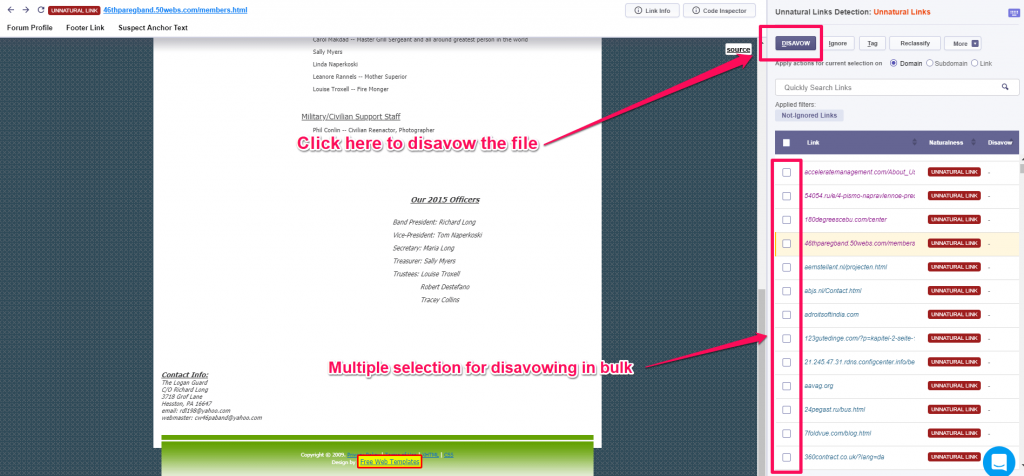
You need to choose the undesirable links and disavow them. You can do this individually or in bulk. The disavowed links will be compiled into a file format recognized by Google, which you can then download and submit directly to Google from the tool.

The disavowal process applies to all categories of links outlined below.
1. Link Networks
To identify links originating from link networks pointing to your website, filter backlinks by blog posts and forum thread links positioned within content, possessing low metrics (such as link influence and domain influence), and a minimal number of incoming links to the backlink itself. The challenge lies in efficiently filtering large lists of links based on content tags and link types (e.g., blog posts, forum pages). This can be done manually or using a tool capable of making these distinctions. To swiftly identify backlinks from link networks, cognitiveSEO provides effective filters. By ordering backlinks in descending order of link influence, you can prioritize examining the lowest quality pages first. Browsing through these links and utilizing the link preview feature facilitates quick evaluation. For instance, cognitiveSEO helped identify 316 low-quality links originating from various pages across different link networks, comprising 17% of their entire backlink profile.
Efficient Strategy to Rapidly Detect Backlinks Originating from Link Networks
Arrange the backlinks in descending order based on Link influence to prioritize examining the lowest quality pages initially. Review the links briefly and utilize the link preview feature to swiftly preview those pages. In our analysis, we identified 316 low-quality links originating from various pages across different link networks, comprising 17% of their entire backlink profile.

To determine if your backlink profile exhibits any signs of being unnatural, it's essential to conduct comparative analyses against your competitors' profiles. I typically compare my site with the top five leaders in the industry, as well as with five other sites striving to establish themselves within the niche. This comprehensive examination often uncovers valuable insights. During the analysis, it's crucial to compare metric distributions, such as link and/or domain influence, link and/or domain trust flow, and link and/or domain citation flow. These comparisons serve as fundamental indicators. For more advanced analyses, delve into comparisons based on factors like webpage type, link type, placement within content, and position within the page.
2. Footer Links
This is one of the reasons why Google has categorized site-wide links as part of link schemes. Such links can skew your analysis and offer little to no SEO value. Consider a scenario where you have one link from one domain versus 100 links from the same domain. In this case, the value of the single-domain link far outweighs that of each individual link originating from the same domain.
If Google detects multiple links from the same domain, they may treat them as a single link. However, from a manual perspective, you could face penalties because Google typically doesn't trust such links and frequently takes manual actions. Having a high volume of footer links can certainly raise concerns with Google. Typically, footer links are obtained from sites that:

There are options when you can easily spot the links that came from footer sections or groups of links. In the cognitiveSEO tool, you have a deep-link analysis where you can spot the inconsistency. Take, for example, the screenshot below:

On the website used for this example (www.addictinggames.com), we observed numerous links originating from blog posts or forum threads, which may not necessarily be detrimental depending on the intent behind them. However, the situation becomes alarming when you consider the sheer number of links stemming from link groups: 8,024, which is a significant volume. Each of these links warrants individual review and swift disavowal; failure to do so may trigger a penalty from search engines. Upon conducting a brief investigation in Site Explorer, it became apparent that the site experienced a substantial decline in rankings due to a penalty. Since then, it has struggled to regain its search visibility.

3. Blogrolls & Other Aggregated Link Collections
This category encompasses both blogroll links and collections of links that deviate from the typical blogroll pattern. An example of such a website is one that previously exploited search engines and doesn't conform to a traditional blogroll structure. Instead, the domain utilizes widgets deployed on multiple websites, allowing webmasters to insert their links. Excessive use of these link patterns may be deemed unnatural by Google's algorithm, potentially resulting in penalties. Additionally, some of these links may be categorized as sitewide links.

Ensure that you refrain from including advanced link widget networks in your site-wide listings, as they are more prone to getting flagged quickly. As with all other link types discussed in this guide, the key lies in how they have been integrated into your link profile.
Revise the health plan to swiftly identify blogrolls and clusters of links.
Just a few filters away, you'll uncover another set of low-quality backlinks that could negatively impact your rankings. In our instance, we identified an additional 424 low-quality links.

We examined that particular backlink using Site Explorer to assess its metrics. What we found was that both the page and domain possessed low authority despite hosting a considerable number of links (47,365) from only 45 referring domains. This pattern strongly indicates the presence of unnatural links. The underlying issue extended beyond this single instance, as the website displayed numerous other unnatural characteristics, with its backlink profile saturated with spammy links. A staggering 88% of their entire link portfolio was deemed unnatural.

Should you encounter a comparable scenario, it is imperative to disavow all unnatural links and promptly submit the disavow file to Google. This action will sever ties with the spammy links that pose a significant threat to burying your website in search results.
4. Links Spanning Entire Sites
claSite-wide links represent yet another instance of detrimental backlinks. They are a well-known issue in the realm of Google rankings. Site-wide links are consistently devalued and can swiftly damage your ranking position. If your domain lacks the requisite authority and garners a few site-wide links from low-quality sites, Google may penalize your website.ss="custom-font mt-5 mb-5"
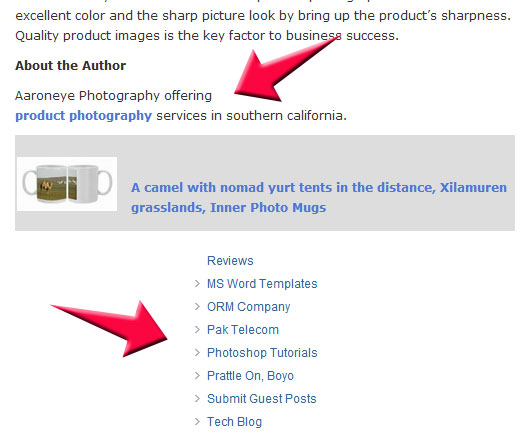
The concept behind site-wide links is straightforward: it's more beneficial to have a greater number of root domains linking to your domain than numerous links originating from fewer root domains. However, not all site-wide links pose a threat to your rankings; their impact depends on the authority of the hosting site. If the site is recognized as authoritative and the site-wide link isn't associated with factors like high link velocity, then it could potentially benefit you.
Efficient Strategy to Rapidly Detect Site-Wide Links
Fortunately, identifying these types of links is straightforward with cognitiveSEO, thanks to its Sitewide Chart feature designed specifically for this purpose. Simply access the chart to view the distribution of sitewide links. If the percentage is significant, delve into the details by clicking on the pie chart to inspect each link individually. In our case, 21% of the entire backlink profile consisted of sitewide links.

The website is burdened with numerous sitewide links that contribute minimal value. Here's an example of a backlink from that site:

This link presents several issues. Not only is it sitewide, but it's also concealed, written in white font. I had to highlight it to reveal the full text. Note: A sitewide link is defined as a link that is automatically duplicated across numerous pages within the same site. It's important not to misclassify a sitewide link as ten distinct links originating from ten separate articles on a site like TechCrunch, for instance. These are not considered sitewide links. Our software incorporates a built-in algorithm that identifies various patterns and determines whether a link qualifies as a TRUE SITE-WIDE or not.
5. Comments on Blogs
Comment spam, a form of spamdexing or keyword stuffing, has been prevalent since the early days of the internet. Various tools aid spammers in automatically posting comments, ultimately aiming to improve search engine rankings. Consequently, many blogging platforms mark comments as "nofollow" to prevent indexing by Google. However, spam commenting remains widespread, and blog owners are well aware of the significant volume of spam comments they receive.
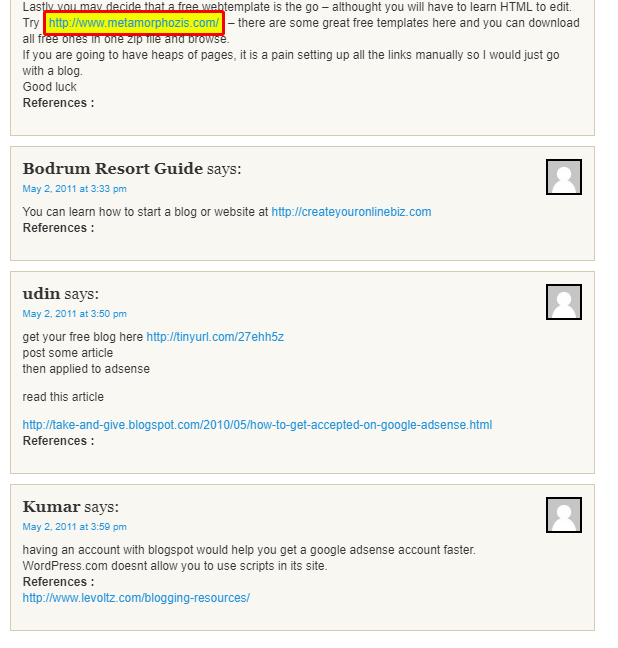
Strategy to Swiftly Detect Blog Comment Links
You can readily identify both nofollow and dofollow links originating from blog comments. For a comprehensive overview of all links stemming from blog comments, simply navigate to the Link Positioning chart and select the Blog Comment section. We encountered a website that concentrated on link building through this method:

Upon reviewing their links, we discovered that the website exploited this black-hat technique by posting spammy blog comments on sites unrelated to their own. Furthermore, they employed anchor text that appeared spammy given the context. The website serves as a free library of e-books and resources, while the site they're linking to focuses on website development—a connection that seems rather tangential.

6. Links and Signatures in Forum Profiles
When people engage in discussions about your site in forums, it's a natural occurrence indicating that your site has generated interest within its niche. However, employing fake forum profiles, signatures, and automated content and link posting for link building can negatively impact your ranking if detected by Google. Such practices create patterns that are easily recognizable by Google's algorithms. Below is an example of an unnatural link originating from a forum.
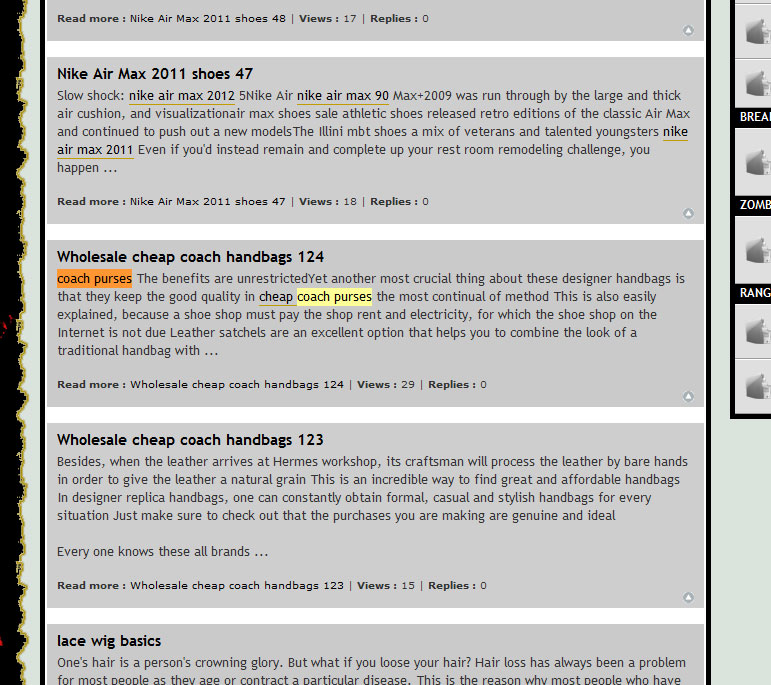
Strategy to Rapidly Identify Forum Links
Once more, cognitiveSEO simplifies the process of pinpointing links originating from forum threads. To examine signatures and profiles, navigate to Link Position » Short Paragraph of Text, Group of Links. Here, you'll find a list of links, as illustrated in the screenshot below.
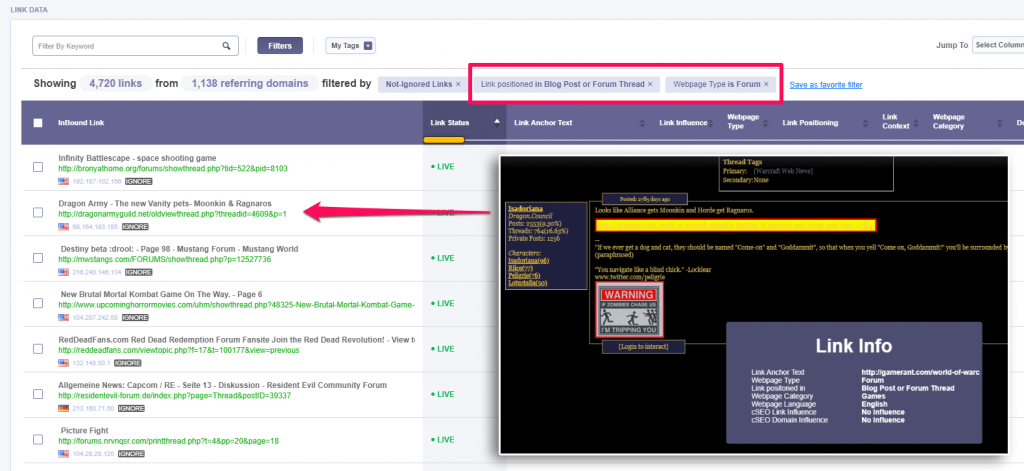
In our example, you'll encounter a preview page containing some link details. Neither the link nor the domain holds any influence. For a swift analysis, head directly to the Link Positioning chart and examine the links from the Blog Post or Forum Thread category. The website we evaluated accumulated numerous links from this source, constituting 15% of the entire backlink profile.

7. Links from Web Directories
Having an excessive number of links originating from web directories can raise a red flag for the Google algorithm. It's unnecessary to be listed on hundreds of directories; instead, focus on a select few quality ones that are reputable in your niche. If a significant proportion of your links stem from directory submissions, whether manually or automatically generated, and whether they were created recently or some time ago, it can trigger a warning due to increased link velocity, potentially leading to penalties. An example of a web directory link is depicted in the screenshot below. Essentially, it comprises a list featuring brief descriptions of brands, each accompanied by a title and a link.

Strategy for Swiftly Identifying Web Directory Links
Should you find yourself faced with a lengthy list of web directory links, particularly if they comprise a significant portion of your inbound link profile as shown in the upcoming screenshot, it could indicate a problem that warrants further investigation. cognitiveSEO monitors backlinks and assesses the overall website's unnaturalness by providing percentages for unnatural, suspect, and okay links, thereby alerting you to any potential dangers.

If your website harbors numerous unnatural links and exhibits red flags, as illustrated above, it's imperative to utilize the disavow tool and sever ties with all spammy links leading to your website. Out of curiosity, we examined the unnatural links and uncovered a multitude originating from spam-filled directories, replete with hundreds of outbound links, akin to the example below. On this page, several issues were evident, including low influence links, thin content, and an excessive number of outbound links. Immediate removal of such links is advisable.

8. Links from Article Directories
If your website harbors numerous unnatural links and exhibits red flags, as illustrated above, it's imperative to utilize the disavow tool and sever ties with all spammy links leading to your website. Out of curiosity, we examined the unnatural links and uncovered a multitude originating from spam-filled directories, replete with hundreds of outbound links, akin to the example below. On this page, several issues were evident, including low influence links, thin content, and an excessive number of outbound links. Immediate removal of such links is advisable.

Strategy for Rapidly Identifying Article Directory Links
Below you can see a print screen for the article directory links identify with our tool. We got 49% unnatural link profile out of their total unnatural links (23,594). Their total unnatural link profile is 87%.

The website experienced numerous impacts from Google algorithm updates, evident in their search visibility. Over the past five years, they've endured multiple penalizations from Google.

In situations like these, it's crucial to disavow all spammy links in bulk and thoroughly cleanse the website. By 2018, a website shouldn't be plagued with such toxic links. It's essential to continuously monitor your backlinks to avoid finding yourself in this predicament.
9. Distribution of Anchor Text
Anchor text typically falls into three categories: - Brand keywords (domain name keywords or the actual brand name) - Money keywords - Navigational keywords (such as "click here," "website," "source," etc.) With cognitiveSEO, you can easily classify and review your anchor texts, obtaining an analysis similar to the one depicted below. A natural distribution of anchor text would resemble this pattern.

A contrived anchor text distribution appears as follows:
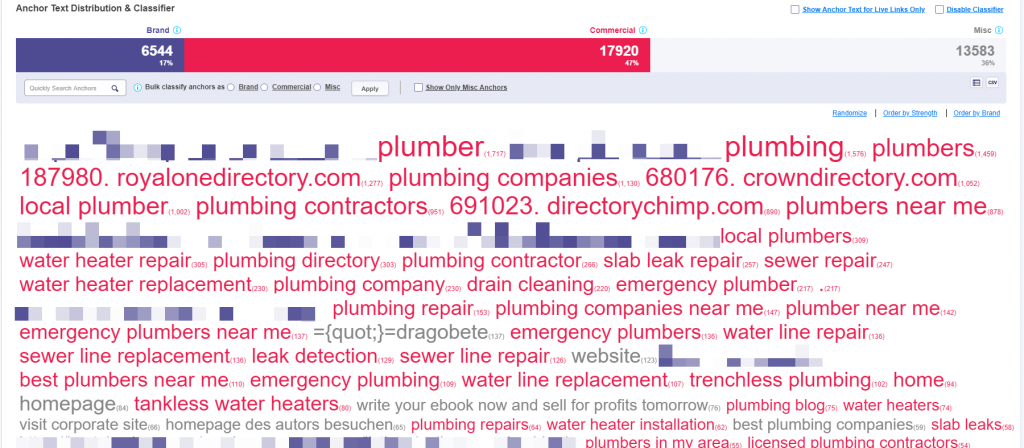
If your anchor text is overly optimized, you're at risk of being penalized by Google, as commercial anchor texts often accompany unnatural links. Instead, opt for a natural anchor text strategy: collaborate with other brands and influencers, create valuable content, and offer high-quality services to garner recommendations and genuine links.
Conclusion
I trust that the SEO tips and step-by-step guide provided here will assist you in identifying potentially toxic links that may have caused issues with Google penalties. Leveraging the cognitiveSEO tool for investigating your link data and conducting a comprehensive link audit can prove invaluable. This tool consolidates all the necessary data in one place and allows you to monitor backlinks alongside your competitors. Avoid building links that could harm your website, even if they were effective in the past. Times have changed, and what once worked may now be detrimental. Utilize these tactics to pinpoint and remove bad links before Google takes action and penalizes your site. It's important to note that black hat tactics are detrimental to everyone and contribute to the deterioration of the internet. Embrace ethical practices, prioritize quality, and Google will reward your efforts.

